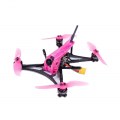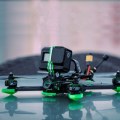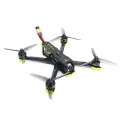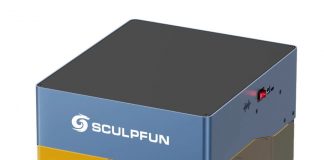iFlight TurboBee 77R
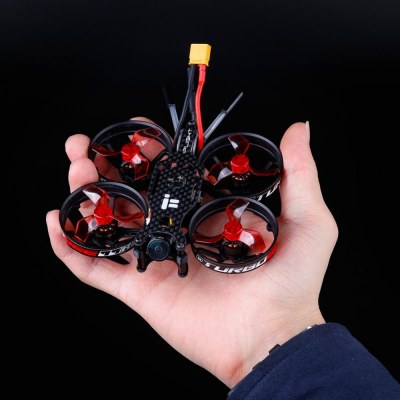
-
1: Frame Wheelbase: 77mm
-
2: Bottom plate thickness: 1.5mm
-
3: Top board thickness: 1mm
-
4: Fpv cam spacing: 19mm
-
5: Build Weight: 55g
iFlight TurboBee 77R 2-4S FPV Racing Whoop RC Drone
This Tinywhoop brushless does not have extraordinary features, it does not have an HD camera, but it seems to be well equipped for safe underwater flights. Its propeller protections prevent the risk of injury, degradation of its flying environment, and of course allow it to remain in flight even after a bite with an obstacle. What is it really worth? Answer in this column.
The TurboBee 77R measures, as its name suggests, 7.7 cm diagonally from engine to engine. So you have to be part of the mid-sized Tinywhoop. Its motorization is based on 1103 to 10000KV brushless motors for Gemfan three-bladed propellers of 4 cm 1635 with a 1.5 mm axis. Its structure is made of 1.5 mm thick carbon, unibody format (one piece). Propeller guards and engines are fixed on the carbon arms. These protections are a little soft to absorb shocks. They partially hide – and protect – the electronics located in the central part.
There is a SucceX flight controller based on an F4 processor, flashed with Betaflight 3.5.7 MatekF411 version with an active OSD and a 4 in 1 ESC of 12A Dshot600, mounted on rubber bumpers to be less sensitive to vibration. The microUSB connector that provides access to the device settings is located between the two propeller covers on the left side. It is difficult to access with a conventional microUSB plug. No problem if you have a bent model – but it’s not an easy cable to find. To solve the problem, iFlight provides an angled adapter. Good idea. However, this adapter is not easy to connect, you still have to twist the propeller covers a little and force them.
The video transmitter is located on the back of the unit. This is a 5.8 GHz model capable of a power of 0 mW (pitmode), 25 mW (the maximum allowed in France), but also 100 mW and 200 mW to go further. It can be controlled via the remote control and the active OSD with the IRC Tramp protocol. The antenna is a dipole with a u.FL connector, with a shock-proof connection thanks to a 3D printed part.
The radio receiver is, on the model I tested, a FrSky XM+ positioned vertically at the rear, with its two antennas sheathed and firmly attached with the same 3D part. It’s clean, neat, and well arranged. The FPV camera at the front is a Caddx Turbo Eos2, 1200TVL mounted between the 2 front spacers with 3D printed PLA supports. The camera is placed very far forward. The advantage? It can be oriented upwards but also downwards. The disadvantage? It is exposed in case of impact. The TurboBee 77R measures 11 x 9.8 x 2 cm (excluding antennas) and weighs 53.8 grams without the battery.
As usual with (almost) flight-ready devices, the PID settings are fully factory set. All that remains is to manage the association with the remote control, the switches to choose the flight modes. Use these settings to change the OSD settings, especially to remove the many excess information that pollutes the video return. Why right now? Because the connection of the microUSB bent accessory is painful enough not to be repeated several times.
I performed most of my tests with 300 and 450 mAh 3S batteries, with an XT30 connector. A few 4S flights were enough for me not to persevere: the engines are very hot, much too hot to ensure a sufficient life span. The camera settings are successful, both in Angle and Horizon stabilized modes and in Acro, without stabilization. The iFlight TurboBee 77R reacts well to controls, it is lively and precise. It allows you to accelerate and fly quite fast, but you quickly find your limits. The recovery of a dive requires a gradual and early go-around or risk of slipping in yaw washout.
SPECS
Product Details
| Features |
SucceX F4 Flight Controller: -STM32F411 -Input voltage 2-4S LIPO -Gyro: MPU6000 -2x UART ports -4x motor outputs -OSD inbuilt -No Blackbox FLASH -BEC 5V 2A Cont. -Size: 21mm*21mm -Mounting holes: 16*16 -Weight: 2.5g -BF target: MATEKF411 SucceX Mirco 12A Brushless ESC: -Firmware: BlheliS -Input voltage : 2-4S LIPO -Continuous current: 12A -MCU: BB21F16G -BEC: None -ESC protocol: PWM, oneshot125, multishot, dshot150, 300, 600, etc. -Size: 23mm*21mm -Mounting hole 16*16mm -Weight: 2.7g SucceX Mirco VTX-Power: PIT/25/100/200mW: -Antenna interface: IPEX (UFL) -Telemetry: IRC Tramp -Size: 17mm*27mm -Mounting holes: 16*16mm -Weight: 1.6g |
| Specification |
- Frame Wheelbase: 77mm - Bottom plate thickness: 1.5mm - Top board thickness: 1mm - Flight control pitch: 16x16mm 20x20mm - Fpv cam spacing: 19mm - Top and bottom plate spacing: 22mm (aluminum column height) - Build Weight: 55g - SucceX Micro 16x16 Tower 2-4S - iFlight 1103 motors (1.5mm shaft) - Caddx.us Turbo Eos2 Camera - Gemfan 1635 40mm 3 blades 1.5mm shaft propeller - iFlight Prop Guards 40mm |
REVIEWS
Disclaimer Note
Ratings are based on objective reviews from our users.



